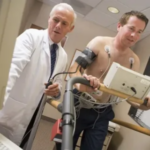
If you or someone you know has been diagnosed with aortic stenosis, you may be wondering what the next steps are. In this article, we will discuss what you need to know about TAVI, a minimally invasive procedure for aortic valve replacement, and how it can help treat aortic stenosis. We will also introduce Dr Rahul Gupta, an interventional cardiologist who specializes in this field.
Introducing Dr Rahul Gupta
Dr. Rahul Gupta is an interventional cardiologist with a focus on structural heart disease and advanced cardiac interventions. He completed his medical training at the University of Delhi in India and pursued further training in interventional cardiology at the University of Miami. He has expertise in TAVI procedures and has helped many patients with aortic stenosis regain their quality of life.
What is Aortic Stenosis?
Aortic stenosis is a condition where the aortic valve becomes narrowed, reducing blood flow from the heart to the rest of the body. This can lead to symptoms such as shortness of breath, chest pain, fatigue, and dizziness. Severe aortic stenosis can even result in heart failure or sudden death. The most common cause of aortic stenosis is calcification of the aortic valve. This is a natural process that happens to the aortic valve as we age. Depending on the age and the severity of the condition, aortic stenosis can be treated with lifestyle changes and medication or more aggressively with TAVI or valve replacement surgery.
What is TAVI?
TAVI, or transcatheter aortic valve implantation, is a minimally invasive procedure to replace the aortic valve without open-heart surgery. During the procedure, a new valve is inserted through a catheter, which is typically inserted through an artery in the groin. Once the new valve is in place, it is expanded and secured in the old valve’s position, restoring normal blood flow. The TAVI procedure is relatively fast and typically lasts no more than 2 hours. It is performed in a hospital setting and most patients can go home 1-2 days after the procedure. Patients often experience a significant improvement in their symptoms within the first week of the procedure and a full recovery within 3-6 weeks. The TAVI procedure is a safe and effective treatment option for those with aortic stenosis. It has been shown to reduce symptoms, improve quality of life and reduce the risk of death and other complications associated with aortic stenosis.
Who is a Candidate for TAVI?
TAVI is typically recommended for patients who are at high or intermediate risk for open-heart surgery or who cannot undergo surgery due to other health issues. Patients with severe aortic stenosis who experience symptoms or have decreased heart function may benefit from this procedure.
The TAVI Procedure:
TAVI is performed in a specialized cardiac catheterization laboratory by an interventional cardiologist and a cardiac surgery team. The procedure typically takes 1-2 hours, and patients are usually under general anesthesia or conscious sedation.
The procedure begins with the placement of a catheter through an artery in the groin or chest, which is guided to the heart. Once the catheter reaches the aortic valve, a balloon is inflated to widen the narrowed valve, allowing the new valve to be inserted.
After the new valve is in place, it is expanded and secured using a balloon or self-expanding mechanism. Once the valve is secure, the catheter is removed and the procedure is complete.
Benefits of TAVI
TAVI offers several advantages over traditional open-heart surgery, including:
- A quicker recovery time.
- Reduced risk of complications, such as bleeding and infection
- No need for a long incision in the chest
- No need for a heart-lung machine
Risks of TAVI
As with any medical procedure, TAVI does carry some risks, including:
- Bleeding or infection at the insertion site
- Damage to the blood vessels or heart
- Irregular heart rhythm
- Stroke or transient ischemic attack (TIA)
However, the overall risk of complications with TAVI is lower than with open-heart surgery.
Conclusion
In conclusion, TAVI is a minimally invasive procedure that offers an effective and safe treatment option for those with aortic stenosis who are not suitable for traditional open-heart surgery. Dr Rahul Gupta, an interventional cardiologist at Cardium specializes in TAVI procedures and has helped many patients with aortic stenosis regain their quality of life. If you or someone you know has been diagnosed with aortic stenosis, it is important to discuss all treatment options with a qualified healthcare professional. To learn more about TAVI and other cardiac interventions.




